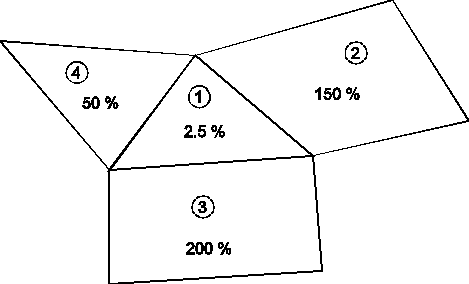After changing the relative K-value in an element follows automatically a local attenuation by considering the K-values of the adjacent elements.
This method avoids large oscillations in adjacent elements during and after the calibration. For each element, the relative change (in %) is compared with the relative changes for the adjacent elements. Depending on the differences, the value is fitted. The procedure is illustrated in a two-dimensional example
|
Element |
K-value of the last iteration step |
New calculated K-value |
Relative change in % |
|
1 |
0,40 |
0,01 |
2,5 % |
|
2 |
0,30 |
0,45 |
150 % |
|
3 |
0,35 |
0,70 |
200 % |
|
4 |
0,30 |
0,15 |
50 % |

The resulting permeability for element 1 is the arithmetic mean of:

the relative change for the hydraulic conductivity in element 1 [%] and

the average of the changes [%] for the adjacent elements
Sample calculation:
½ * (2,5 % + (150 % + 200 % + 50 %)/3) = ½ * (2,5 % + 133,33 %) = 67,92 %
 The permeability K for element 1 is decreased to 67.92 % of the initially computed value. It is now decreased from 0.40 to 0.271.
The permeability K for element 1 is decreased to 67.92 % of the initially computed value. It is now decreased from 0.40 to 0.271.
In the case of a three-dimensional model, the adjacent elements in the vertical direction are also taken into account. Layers with permeabilities of different magnitudes (aquifers and aquitards) are automatically detected and taken into proper consideration. Adjacent elements which belong to hydraulically different layers are weighted with smaller factors.
